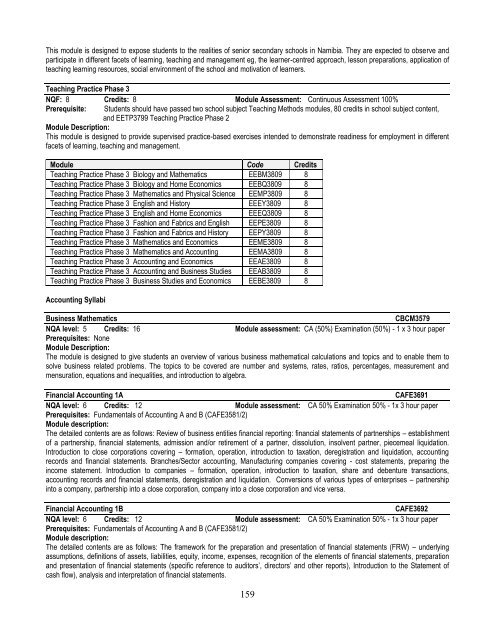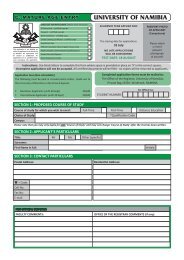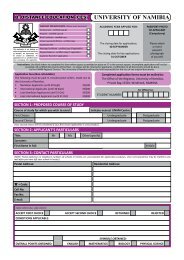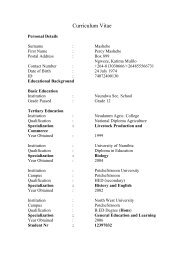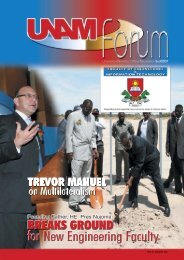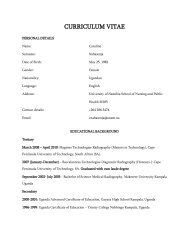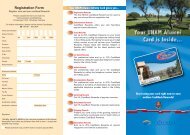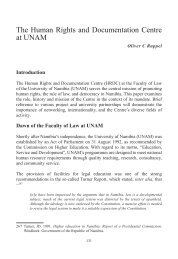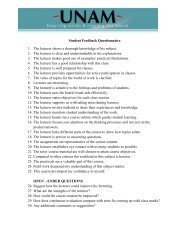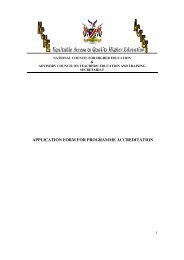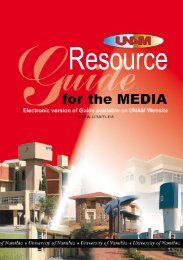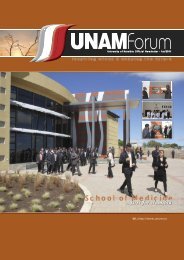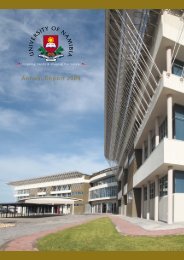UNIVERSITY OF NAMIBIA CENTRE FOR EXTERNAL STUDIES ...
UNIVERSITY OF NAMIBIA CENTRE FOR EXTERNAL STUDIES ...
UNIVERSITY OF NAMIBIA CENTRE FOR EXTERNAL STUDIES ...
You also want an ePaper? Increase the reach of your titles
YUMPU automatically turns print PDFs into web optimized ePapers that Google loves.
This module is designed to expose students to the realities of senior secondary schools in Namibia. They are expected to observe andparticipate in different facets of learning, teaching and management eg, the learner-centred approach, lesson preparations, application ofteaching learning resources, social environment of the school and motivation of learners.Teaching Practice Phase 3NQF: 8 Credits: 8 Module Assessment: Continuous Assessment 100%Prerequisite: Students should have passed two school subject Teaching Methods modules, 80 credits in school subject content,and EETP3799 Teaching Practice Phase 2Module Description:This module is designed to provide supervised practice-based exercises intended to demonstrate readiness for employment in differentfacets of learning, teaching and management.Module Code CreditsTeaching Practice Phase 3 Biology and Mathematics EEBM3809 8Teaching Practice Phase 3 Biology and Home Economics EEBQ3809 8Teaching Practice Phase 3 Mathematics and Physical Science EEMP3809 8Teaching Practice Phase 3 English and History EEEY3809 8Teaching Practice Phase 3 English and Home Economics EEEQ3809 8Teaching Practice Phase 3 Fashion and Fabrics and English EEPE3809 8Teaching Practice Phase 3 Fashion and Fabrics and History EEPY3809 8Teaching Practice Phase 3 Mathematics and Economics EEME3809 8Teaching Practice Phase 3 Mathematics and Accounting EEMA3809 8Teaching Practice Phase 3 Accounting and Economics EEAE3809 8Teaching Practice Phase 3 Accounting and Business Studies EEAB3809 8Teaching Practice Phase 3 Business Studies and Economics EEBE3809 8Accounting SyllabiBusiness MathematicsCBCM3579NQA level: 5 Credits: 16 Module assessment: CA (50%) Examination (50%) - 1 x 3 hour paperPrerequisites: NoneModule Description:The module is designed to give students an overview of various business mathematical calculations and topics and to enable them tosolve business related problems. The topics to be covered are number and systems, rates, ratios, percentages, measurement andmensuration, equations and inequalities, and introduction to algebra.Financial Accounting 1ACAFE3691NQA level: 6 Credits: 12 Module assessment: CA 50% Examination 50% - 1x 3 hour paperPrerequisites: Fundamentals of Accounting A and B (CAFE3581/2)Module description:The detailed contents are as follows: Review of business entities financial reporting: financial statements of partnerships – establishmentof a partnership, financial statements, admission and/or retirement of a partner, dissolution, insolvent partner, piecemeal liquidation.Introduction to close corporations covering – formation, operation, introduction to taxation, deregistration and liquidation, accountingrecords and financial statements. Branches/Sector accounting, Manufacturing companies covering - cost statements, preparing theincome statement. Introduction to companies – formation, operation, introduction to taxation, share and debenture transactions,accounting records and financial statements, deregistration and liquidation. Conversions of various types of enterprises – partnershipinto a company, partnership into a close corporation, company into a close corporation and vice versa.Financial Accounting 1BCAFE3692NQA level: 6 Credits: 12 Module assessment: CA 50% Examination 50% - 1x 3 hour paperPrerequisites: Fundamentals of Accounting A and B (CAFE3581/2)Module description:The detailed contents are as follows: The framework for the preparation and presentation of financial statements (FRW) – underlyingassumptions, definitions of assets, liabilities, equity, income, expenses, recognition of the elements of financial statements, preparationand presentation of financial statements (specific reference to auditors’, directors’ and other reports), Introduction to the Statement ofcash flow), analysis and interpretation of financial statements.159


